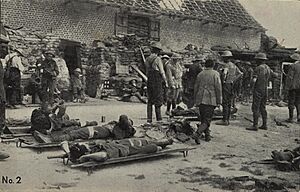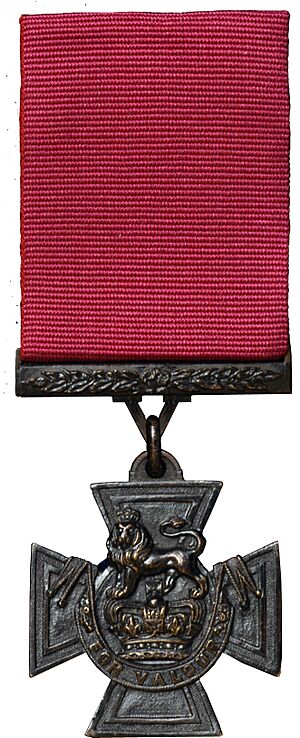Lawrence Weathers facts for kids
Quick facts for kids
Lawrence Weathers
|
|
|---|---|

Private Lawrence Weathers c. 1916
|
|
| Born | 14 May 1890 Te Kōpuru, New Zealand |
| Died | 29 September 1918 (aged 28) Saint Quentin Canal, Péronne, France |
| Allegiance | Australia |
| Service/ |
Australian Imperial Force |
| Years of service | 1916–1918 |
| Rank | Corporal |
| Unit | 43rd Battalion |
| Battles/wars | World War I
|
| Awards | Victoria Cross |
Lawrence Carthage Weathers (born May 14, 1890 – died September 29, 1918) was a very brave Australian soldier. He was born in New Zealand, but his family moved to South Australia when he was seven years old. Before joining the army, he worked as an undertaker in Adelaide.
In early 1916, Weathers joined the Australian Imperial Force (AIF) as a private soldier. He became part of the 43rd Battalion. His unit was sent to the Western Front in France and Belgium in late December 1916.
Weathers fought in many important battles. These included the Battle of Messines in June 1917, where he was wounded. He also fought in the German spring offensive and the Battle of Hamel. He was awarded the Victoria Cross, the highest award for bravery in battle for Australian soldiers. He received this award for his amazing courage during the Battle of Mont Saint-Quentin in September 1918. Sadly, he died from his wounds on September 29, 1918, during the Battle of St Quentin Canal, not knowing he would receive the Victoria Cross.
Contents
Lawrence Weathers' Early Life
Lawrence Weathers was born in Te Kōpuru, a small town near Dargaville, New Zealand. His birthday was May 14, 1890. He was one of eight children. His parents, John and Ellen Weathers, were from Adelaide, Australia.
When Lawrence was seven, his family moved back to South Australia. They lived in the countryside, and he went to Snowtown Public School. After school, he traveled to Europe and America for two years with two of his brothers. When he returned to Australia, he worked with horses and later became an undertaker in Adelaide.
On September 10, 1913, Lawrence married Annie Elizabeth Watson. They had two children together. Lawrence's older brother, Thomas, also fought in World War I and sadly died in 1915 during the Gallipoli Campaign.
Weathers' Service in World War I
On February 8, 1916, Lawrence Weathers joined the Australian Imperial Force (AIF). He started as a private soldier. In June, he was moved to the 43rd Battalion. This battalion was part of the 3rd Division.
The 43rd Battalion sailed to England in June 1916. They trained there for several months. In November, they moved to the Western Front in France. They entered the trenches for the first time in late December.
First Battles and Injuries
In January 1917, Weathers became sick and did not rejoin his unit until April. He returned just in time for his battalion's first big battle, the Battle of Messines. This battle happened in June 1917. The 43rd Battalion had to capture a specific line of enemy trenches.

During the fighting, Weathers was shot in the leg on June 10. He was sent to a hospital in the United Kingdom to recover. He did not return to his unit until early December. The soldiers spent the winter of 1917–1918 improving their trenches. They knew a big German attack was coming.
Facing the German Offensive
On March 21, 1918, Weathers was promoted to lance corporal. A week later, his battalion helped stop the German spring offensive. They took up defensive positions between the Ancre and Somme rivers.
In late May, Weathers needed medical help after a gas attack near Villers-Bretonneux. This attack caused many casualties in his battalion. Weathers did not return to duty until mid-June.
Heroic Actions and the Victoria Cross
The 43rd Battalion's next major battle was the very successful Battle of Hamel on July 4. The battalion helped clear the village itself. They then played a supporting role in the Battle of Amiens on August 8. This battle marked the start of the Hundred Days Offensive, which aimed to push the Germans back.
On September 2, during the Battle of Mont Saint-Quentin, Weathers showed incredible bravery. His battalion was trying to clear enemy trenches north of the village of Allaines. They captured one trench easily. Then, they fought their way north using hand grenades. They managed to trap about 150 German soldiers in a trench.
The German soldiers fired heavily, stopping the Australian advance. Weathers, supported by three other men, broke the deadlock. He went forward alone under heavy fire and attacked the enemy with bombs. He then returned for more bombs and went forward again with his three comrades.
Even though it was very dangerous, he climbed onto the enemy's trench wall. He threw bombs into the trench. With the help of his comrades, he captured 180 prisoners and three machine guns! His amazing courage and determination helped capture the objective. It also saved the lives of many of his fellow soldiers.
For these actions, Lawrence Weathers was recommended for the Victoria Cross. This is the highest award for bravery in battle for Australian soldiers.
Final Battle and Legacy
When Weathers returned to his friends, he was covered in mud and blood. He was also carrying captured German binoculars and pistols. He was very excited and told his mates how he had scared the Germans.
On September 10, Weathers was promoted to temporary corporal. On September 29, the 3rd Division was part of the Battle of St Quentin Canal. This was one of the last Australian ground actions of the war. During the battle, Weathers' battalion was in a trench when a shell exploded nearby. Weathers was hit in the head and died soon after. He never knew that he would receive the Victoria Cross. The award was officially announced on December 24, 1918. The same shell that killed Weathers also killed his uncle, Lance Corporal J. J. Weathers.
Lawrence Weathers was buried at the Commonwealth War Graves Commission Unicorn Cemetery in Vendhuile, France. For many years, his Victoria Cross medal was owned by private collectors. In 2016, it was bought at an auction and given to the Australian War Memorial in Canberra. You can now see his Victoria Cross displayed there in the Hall of Valour.


